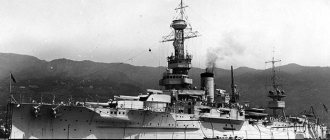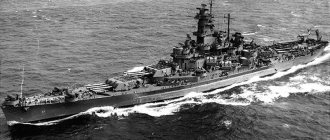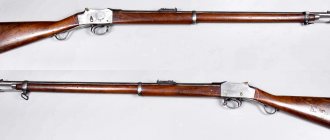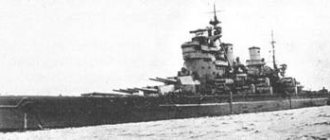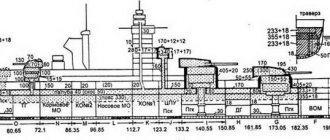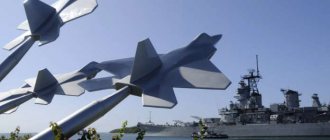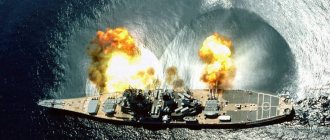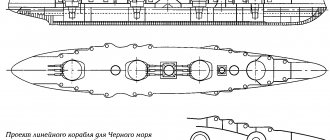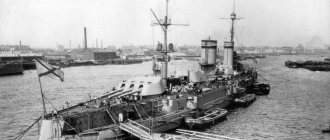Home » Alternative shipbuilding - Fleets that never existed » What the Russian battleship Nelson could have become
Alternative shipbuilding - Fleets that never existed
boroda 07/14/2019 2658
13
in Favoritesin Favoritesfrom Favorites 7
The battleship Lenin was mentioned on our website in a review of the Soviet branch of World of Warships battleships. Here is a more detailed analysis of a single battleship from this wonderful game.
This ship is one of the design versions of fast battleships armed with 406 mm artillery, developed as part of the USSR large fleet program in the second half of the 30s. A special feature of this project was the location of the main battery compartment at the front of the ship. Solid armor and large caliber form the ideal combination for crushing enemy ships.
Ship history
In 1935, new challenges in international politics forced the USSR to change its concept of shipbuilding, which until then had not paid enough attention to battleships. These changes gave designers the green light to begin developing several battleships. In 1936, technical specifications were prepared. Project 21, a sketch of a warship intended for service in the Baltic Sea, was created by the design bureau of the Baltic Shipyard based on the technical specifications provided. Features of the project: displacement 35,000 tons; main battery consisting of nine 406 mm cannons; Armored body 350 mm thick. The sketch was ready in June. The layout of the ship's main turrets was similar to that known from the British battleship Nelson, with three turrets located at the front. The ship was also equipped with additional 152 mm armament, as well as 100 mm long-range anti-aircraft guns. The engineers decided to use a protection system from the Italian Pugliese. However, the Nelson-like appearance was rejected by headquarters after heated discussion for "tactical reasons." The experience gained during the development of Project 21 was used as the basis for the Type A Battleship project, which later evolved into the Soviet Union class battleship.
Hunting for a battleship, or the unsinkable Nelson
During the Battle of the Atlantic, German submarines sent about 200 enemy warships to the bottom. An attack on an enemy ship was considered a very honorable matter and, if successful, would not go without reward, but it was not a priority, since the main target for submarines always remained merchant ships. An exception was made only for large ships - aircraft carriers and battleships, the sinking of which promised immediate award of the Knight's Cross.
It is not surprising that German submariners passionately dreamed of meeting such “prey” and attacked heavy ships at the first opportunity. Such a hunt was often accompanied by oddities that were associated with errors in target identification. The hero of two similar stories was the English battleship HMS Nelson, which was twice “torpedoed” by German submarines.
The battleship Nelson and her sister ship Rodney had a unique, recognizable silhouette - three main gun turrets were located in front of the superstructure. The ship remained in service from 1930 to 1948.
Error in radiogram
On December 5, 1939, the submarine U 23 (type IIB) under the command of Captain-Lieutenant Otto Kretschmer set sail from Kiel, assigned to operate against shipping in the area of the north-east coast of Scotland and the Shetland Islands. On December 7 at 23:26, when changing position, the boat discovered and attacked a convoy of four ships, but the torpedoes missed their targets. Kretschmer achieved success half an hour later, attacking and sinking the single steamer Scotia (2400 tons), flying the flag of neutral Denmark.
Four days later, a curious incident occurred. On the night of December 12, U 23, while off the Shetland Islands, at 02:08 fired two torpedoes in succession at a destroyer that was anchored in Yell Sound. One of the torpedoes exploded, sending a tall column of flame into the air. On the boat they decided that the ship had been torpedoed, which was reported to headquarters. However, the British did not suffer any losses in destroyers in this area that day, and the torpedoes most likely hit a rock, which in the dark on U 23 was mistaken for a warship.
The submarine U 23 was captured by a photographer in the pre-war period, as evidenced by the large number on the wheelhouse - it was painted over after the start of hostilities
Canadian explorer Terence Robertson, in his biography of Otto Kretschmer, tells a funny story: when Kretschmer realized his mistake, he sent a humorous report to headquarters: “The rock was torpedoed. Didn't sink"
. This had certain consequences when U 23 returned to base:
“ Returning to Kiel, they learned that
U 23 had spent more time at sea than any other boat in their flotilla.
Having come on board the mothership with a report, Kretschmer was surprised to find that everyone, without exception, was happy with his success. Since he himself was very dissatisfied with his mistakes, he was not pleased with the general enthusiasm. He was even more surprised when Dönitz himself demanded from him a detailed report on all actions during the campaign. After reading the report, Dönitz sent for Kretschmer and asked why he kept silent in the report about the torpedo attack on the Nelson. - "Nelson"? – Kretschmer was completely sincerely amazed. “But I didn’t torpedo the Nelson!” I didn't even see him!- What?
- Dönitz yelled. He called the communications chief and ordered the report on the last campaign of U 23 to be immediately delivered to him. - Here!
– he exclaimed and pointed to the right place on the paper. – Read what is written here! Still perplexed, Kretschmer read the message: “Nelson” was torpedoed, but did not sink.”
It took him a few seconds to realize his mistake. The fact is that rock in German is “ Felsen ”. Somewhere during the decoding of the radiogram it was transformed into “ Nelson ” .
Dönitz sat down.“Rock,” he muttered, as if talking to himself. - So the whole point is that you attacked the rock. – A minute later he was shaking all over with laughter. - Oh, Kretschmer, if only you knew what I’m thinking about now. It seems we both have no reason to be happy. Imagine for a moment Goebbels' face when he finds out about this.
Dönitz picked up the phone and asked to speak to the Ministry of Propaganda in Berlin. Then he turned to Kretschmer:
- Okay, go. I'll make sure today's show is cancelled. They were going to ask Churchill where Nelson was now. It doesn’t take a highly developed imagination to guess what answer the English Prime Minister would give.”
For Kretschmer, the incident with the rock ended in a pun, but history tends to repeat itself, and the incident with “Nelson” continued. True, this time the hero who torpedoed the British battleship was another future German ace.
Squadron of stone
On January 13, 1940, the submarine U 25 (type IA) under the command of Lieutenant Commander Viktor Schütze set out from Wilhelmshaven. The commander of the boat received an order to go out into the Atlantic, rounding the British Isles from the north, and, having reached the Bay of Biscay, begin patrolling the approaches to it. The start of the voyage was successful - on the day of January 17, U 25 sank two ships: the British Polzella (4751 tons) and the Norwegian Enid (1140 tons).
Loading a torpedo into the bow compartment of the submarine U 25
Having chalked up almost 6,000 tons, Schütze continued his hunt the next day. While north of the Hebrides, U 25 encountered a darkened vessel escorting a patrol ship. The boat launched an attack and within half an hour fired three single torpedo salvoes. The first and third torpedoes hit the target, and 27 minutes after the second hit the ship sank. During this time, the escort managed to pick up its crew from the water, after which, having discovered the submarine on the surface, it was driven under the water with artillery fire and dropped depth charges after it. But fate favored Schütze, and U 25 safely escaped from its pursuer. The sunken ship turned out to be the Swedish Pajala (6873 tons), which, accompanied by a British PLO trawler, was heading to Kirkwall to be inspected for smuggling.
By the evening of January 18, the boat was north of Scotland off the island of Sula Sgeir. At 19:12, being a short distance from this island, Schütze noticed the shadows of two large ships sailing in the wake column. The boat identified them as battleships. At 19:20, Schütze fired a torpedo from a distance of 1200 meters at the largest ship, which he identified as the battleship Nelson, but missed. The boat made a turn in order to attack the target from the stern devices, but at that moment, having approached, Schütze clearly saw that what he took for ships turned out to be rocks! In the war log of U 25 Schütze with irritation about
With a strong desire, the rocks of the island of Sula Sgeir can easily be mistaken for an enemy squadron
The boat commander's dissatisfaction is understandable. Schütze's annoyance was that he not only wasted a precious torpedo, but also failed to even hit the rock, which he mistook for an enemy battleship. The commander of U 25 was extremely dissatisfied with himself, but did not report his attack on the “enemy warship” to headquarters.
Perhaps Schütze did not have the same sense of humor as Kretschmer, or perhaps he knew about the story that had happened earlier with U 23, so he did not want to expose himself to ridicule. If in the case of U 23 Kretschmer was sure that the attack was a destroyer, then Schütze raised the status of the Scottish rocks to the level of a battleship. True, the commander of U 25 deprived Dr. Goebbels of the opportunity to trumpet the torpedoing of a British battleship, noticing his mistake in time.
The losers of the imaginary attacks on the Nelson are the commander of U 23, Lieutenant Commander Otto Kretschmer, and the commander of U 25, Lieutenant Commander Victor Schütze.
It is worth noting that the real Nelson also did not escape attacks from German submarines. Early in the morning of October 30, 1939, west of the Orkney Islands, U 56 of Lieutenant Commander Wilhelm Zahn attacked the British squadron consisting of the battle cruiser HMS Hood, the battleships HMS Rodney and Nelson, as well as 10 destroyers. Tsang fired three torpedoes at the Nelson, but was severely disappointed - on the boat they heard the sound of a metal impact, which was mistaken for undetonated torpedoes hitting the ship. According to unverified information, the entire color of the British fleet was on the Nelson at that moment: the commander of the Home Fleet, Admiral Sir Charles Forbes, the First Sea Lord Sir Dudley Pound, the First Lord of the Admiralty Winston Churchill. But if fate favored “Nelson” that day, then a month later she turned away from him. On December 4, 1939, the battleship was seriously damaged when it hit a mine laid by the German boat U 31 at the entrance to Loch Ewe. The damage from the explosion was so severe that the ship was forced to undergo six months of repairs in Portsmouth and did not return to service until June 8, 1940.
* * *
If we compare both cases of mistaken attacks with a real hunt for an animal, then probably more than one predator hunter in the taiga shot at a block or stump, mistaking them for a tiger or a bear. It is perhaps much worse when, on the contrary, a tiger or a bear is mistaken for a stump. It is worth noting that for Schütze and Kretschmer everything ended well, but if real ships had been mistaken for the rocks, then the submariners would have had no reason to joke.
The first watch officer of U 23 Adalbert Schnee smokes a pipe on the bridge of the boat
An interesting fact is that almost all the main participants in these events subsequently became famous submariners. Kretschmer and Schütze were among the top five German submarine aces of World War II. Their watch officers Adalbert Schnee, Eitel-Friedrich Kentrat and Hans-Dietrich von Tiesenhausen, having become submarine commanders, also became aces, and the latter even managed to torpedo and sink the real battleship. On November 25, 1941, the U 331 torpedoes of Captain-Lieutenant von Tiesenhausen sent the British battleship Barham to the bottom of the Mediterranean Sea. But first there were rocks...
List of sources and literature:
- Robertson T. Submarine ace of the Third Reich. – M.: Tsentrpoligraf, 2009
- Berr R. Das Kriegstagebuch der U-Bootwaffe (https://www.ubootwaffe.net)
- Ritschel H. Kurzfassung Kriegstagesbuecher Deutscher U-Boote 1939–1945 Band 1. Norderstedt
- Bush R., Roll H.-J. Der U-boot-Krieg 1939–1945. Deutsche Uboot-Erfolge von September 1939 bis Mai 1945. Band 3. – Verlag ES Mittler & Sohn, Hamburg-Berlin-Bonn, 2001
- Wynn K. U-Boat Operations of the Second World War. Vol.1–2 – Annopolis: Naval Institute Press, 1998
- Blair S. Hitler's U-boat War. The Hunters, 1939–1942 – Random House, 1996
Ship reconstruction
The model represents the theoretical appearance of the ship in 1944 if the keel was built in 1936 and if it was built according to the original Project 21 plans.
Main battery:
Consists of 406mm/45 caliber cannons mounted on three triple mounts mounted at the front of the ship. The game uses the developments of the department of the Obukhov Metallurgical Plant.
The gun was created by the end of 1913 by engineers at the Obukhov plant under the leadership of the General Staff of the Naval Forces and the Supreme Command of Naval Facilities. The order for weapons was submitted in February 1914 at the Obukhov Metallurgical Plant.
The project existed solely on paper and was never realized due to the fact that other urgent orders for the army were placed at the plant. The design of the work assumed the following combat characteristics: projectile weight 1116 kg; payload 332 kg; muzzle velocity 840 m/s.
Additional battery:
Four triple MK-3-152 guns of 152 mm caliber. located in MK-3-180 towers.
The B-38's guns were to be installed on Project 23 gun battleships, Project 69 heavy cruisers , and Project 68 light cruisers . However, production of these ships was stopped during World War II, and the B-38 was installed on five Project 68K cruisers and fourteen Project 68bis cruisers after the end of the war.
Anti-aircraft weapons:
Long-range anti-aircraft artillery consists of six twin MZ-14 guns equipped with 100 mm B-54 cannons. Short-range air defense includes eight two-gun 46-K 37 mm caliber mounts and ten two-gun V-11 mounts, also 37 mm caliber.
Nelson's flagship - HMS Victory ("Victory")
One of the most popular English museums is Her Majesty's Ship (HMS), or her (his) Majesty's ship - the famous ship of the sailing age Victory ("Victory"), which has been docked in the Portsmouth naval dock since January 12, 1922. The exhibit attracts up to two thousand visitors every day, bringing in considerable income that goes towards maintaining the unusual museum. The ship became famous due to its unusual history, which will be discussed below.
The three-masted Victory was built in Chatham (England) for almost six years (from 07/23/1759 to 05/07/1765) under the leadership of prominent shipbuilders D. Lock and E. Allin. The beauty of the ship, its 60-centimeter side and over 100 different-caliber guns impressed contemporaries. The construction of the giant took more than 2,500 perennial elms, oaks and other trees, and the crew at different times consisted of 850-950 people. The ship's hull had two skins, and the underwater part was later covered with copper, the sheets of which were attached to the skin with metal nails.
The displacement of the flagship of the English navy was 3,500 tons, with a length of 69 and a width of 15.7 meters. The area of its sails reached 260 m2, which made it possible to move at speeds of up to 11 knots (about 20 km/h). All this, however, did not help the ship to surpass the size of the Spanish ship Santisima Trinidad.
Battleship Lenin in battle
Lenin's main weapon is his fairly accurate 406mm cannons, housed in three-gun turrets at the front of the hull. Firing range: 18.4 km; Reload time 33 seconds. Most of all, you can appreciate the accuracy of shooting from these guns at short and medium distances. This is also combined with the high speed of rotation of these towers - 180 degrees in just 30 seconds.
Good armor is a typical feature of USSR battleships. This armor will allow you, especially at close ranges, to feel more confident and often avoid damage. The rear armor belt is 100 mm thick and can repel attack more effectively than most battleships of this tier, and its deck provides reliable protection against medium-caliber artillery.
The repair team has an accelerated recovery time, although the number of opportunities to use it is limited, which will have a negative impact at the end of the battle. Repair time: 10 seconds, recovery time: 60 seconds.
Construction and career[edit]
Nelson
and
Rodney
By the end of the war Rodney
had been in use for many years without significant refurbishment or repair, and it was worn out, especially its hardware.
[9] Nelson
was refitted in the United States in late 1944 and was in good enough condition to serve in the post-war navy, including a short time as the flagship of the Home Fleet in late 1945.
Rodney
was scrapped in 1948.
Inverkeithing, shortly after the revenge of the Queen Elizabeth-class battleship and Nelson
in 1949 after its use as a target for bombing trials.
“According to Winston Churchill's memoirs, a major modernization was discussed to enable Nelson
to serve for several years in the post-war navy, but no other details survive.
In any case, Nelson
was too slow for the modern navy, which no longer had the forward role of battleships" [20].
Links[edit]
- Brown, David K. (1999). Grand Fleet: Warship Design and Development 1906–1922
. Annapolis, MD: Naval Institute Press. ISBN 1-55750-315-X. - Brown, David K. (2000). Nelson - Vanguard: Design and Development of a Warship 1923–1945
. Annapolis, MD: Naval Institute Press. ISBN 1-55750-492-X. - Burt, R. A. (2012). British Battleships, 1919–1939
(2nd ed.). Annapolis, MD: Naval Institute Press. ISBN 978-1-59114-052-8. - Campbell, John (1985). Naval weapons of World War II
. Annapolis, MD: Naval Institute Press. ISBN 0-87021-459-4. - Friedman, Norman (2015). British battleship 1906–1946
. Barnsley, UK: Seaforth Publishing. ISBN 978-1-84832-225-7. - Robert Gardiner, ed. (1980). All Conway's World Warships 1922-1946
. London: Conway Maritime Press.CS1 maint: extra text: authors list (link) - Rear Admiral GGO Gatacre, Reports of
the Meetings
1921–1964
(Nautical Press & Publications, Manly, NSW, Australia, 1982) ISBN 0 949756 02 4 - Jordan, John (2020). Nelson
and
Rodney
Six-Inch Turrets ."
In Jordan, John (ed.). Warship 2020
. Oxford, UK: Osprey. pp. 184–188. ISBN 978-1-4728-4071-4. - Lenton, H. T. (1998). British and Imperial warships of the Second World War
. Annapolis, MD: Naval Institute Press. ISBN 1-55750-048-7. - Parks, Oscar (1990). British battleships
(reprint 1957 edition). Annapolis, MD: Naval Institute Press. ISBN 1-55750-075-4. - Raven, Alan and Roberts, John (1976). British Battleships of the Second World War: Development and Technical History of the Royal Navy's Battleship and Battlecruisers from 1911 to 1946
. Annapolis, MD: Naval Institute Press. ISBN 0-87021-817-4. - Stern, Robert S. (2017). A Celebration of the Battleship: Naval Treaties and Capital Ship Design
. Barnsley, UK: Seaforth Publishing. ISBN 978-1-84832-344-5.
Notes[edit]
- British Battleships 1939-45 (II)
, Angus Konstam, Osprey Publishing. - ^ abcdef Preston, Anthony. Battleships
. London: Buffalo Books. ISBN 0861242599. - ^ B s d e g h i Burt, p.
- ^ a b c d Brown 1999, p.
- ↑
Burt, pp. 348–349. - ↑
Raven & Roberts, pp. 126–127. - Jump up
↑ Burt, pp. 350, 357–359 - ↑
Raven & Roberts, pp. 114, 124–125. - ^ abc HMS Rodney
, Iain Ballantyne, Pen & Sword Books, ISBN 978 1 84415 406 7 - French Battleships 1922-1956
, John Jordan and Robert Dumas, Seaforth Publishing, ISBN 978 1 84832 034 5 - ^ ab Reports of
the proceedings
1921–1964
, GGO Gatacre, ISBN 0 949756 02 4 - Jump up
↑ Raven & Roberts, p. 118 - Reports of
the proceedings
1921-1964
, GGO Gatacre, Nautical Press & Publications, Sydney, 1982, ISBN 0 949756 02 4, p.140 - On His Majesty's Service, 1940-41
, Joseph H. Wellings, https://www.ibiblio.org/anrs/docs/D/D7/1002wellings_onhismajestysservice.pdf - Ballantyne, page 142
- ↑ Killing the Bismarck
, Iain Ballantyne, Pen & Sword Books, Yorkshire, ISBN 978 1 84415 983 3, pp. 258–260. - The Pursuit: The Wreck of the Bismarck
, Ludovic Kennedy, William Collins, ISBN 0 00 211739 8 - Conway All the Fighting Ships in the World 1922-1946 (First American Edition)
. New York: Mayflower Books Inc., 1980. p. 14. ISBN 0-8317-0303-2. - Bert, page 377
- Conway's Battleships
, Ian Sternton, Conway Maritime Press, London, 2008, ISBN 978 1 844860 685, p. 135

